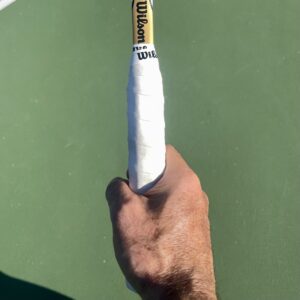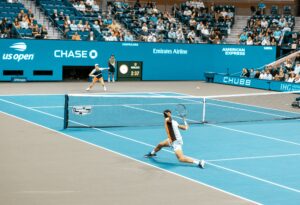Introduction to Volley Tennis
Volley tennis is a skillful game tactic demanding agility, precision, and quick reflexes. It’s a unique aspect of the sport that sets it apart from others. It’s not just about power and technique, but finesse and subtlety as well.
Volleying is an art, requiring a player to make split-second decisions, respond quickly, and strategically place the ball where the opponent least expects it. The game of volley tennis isn’t for everyone. It demands a certain level of skill and experience that only comes with practice. But for those willing to put in the time and effort, the rewards are great.
Without a doubt, volley tennis offers an exciting, fast-paced game that’s sure to keep both players and spectators on the edge of their seats.
Importance of Net Game in Tennis
The net game is a crucial aspect of tennis. It’s where the game can be won or lost. A strong net game can give a player a significant advantage, enabling them to control the court and dictate the pace of the match. Conversely, a weak net game can leave a player vulnerable, offering their opponent opportunities to seize control and gain the upper hand.
Net play in tennis requires a player to be agile, quick, and precise. It’s about timing and placement, about being in the right place at the right time and hitting the ball at just the right angle. A player with a strong net game can keep their opponent guessing, constantly changing the direction and speed of the ball to keep them off balance.
But the net game isn’t just about physical skill. It’s also about mental acuity. A player needs to be able to read their opponent, anticipate their moves, and react accordingly. They need to be able to think on their feet, make quick decisions, and adapt their strategy as the game evolves. The net game is a chess match played at lightning speed, where the player with the sharpest mind and quickest reflexes often comes out on top.
Understanding the Volley Technique: Grip, Stance, and Body Position
Mastering the art of volley tennis starts with understanding the basics: the grip, the stance, and the body position. These foundational elements are crucial to developing a strong volley technique and improving your net play.

- Grip: The grip is the first point of contact between the player and the racket. It’s what controls the angle and direction of the racket head, and ultimately, the ball. The correct grip for volleying is the Continental Grip. This grip allows for a natural wrist movement and provides the perfect balance of power and control.
- Stance: The stance is equally important. A good volley stance is one where the player is balanced, agile, and ready to move in any direction. The player’s feet should be shoulder-width apart, knees slightly bent, and weight evenly distributed between both feet. The player should be on their toes, ready to spring into action at a moment’s notice.
- Body Position: The player should be facing the net, body slightly turned towards the direction of the incoming ball. The non-dominant hand should be pointing towards the ball, guiding the racket to the point of contact. Maintaining the correct body position is crucial for executing precise and effective volleys.
Developing Your Technique: Key Elements to Master Forehand and Backhand Volley
Developing your volley technique is a process. It involves mastering several key elements, each of which contributes to the overall effectiveness of your volley. These elements include footwork, racket preparation, point of contact, and follow-through.
Footwork
Footwork is the foundation of a good volley. It’s what enables a player to get to the ball quickly and position themselves correctly for the shot. Good footwork involves staying on the balls of your feet, taking small, quick steps, and maintaining balance and agility at all times.
Racket Position
Racket preparation is about getting your racket ready for the shot. Your racket should be back and up, ready to strike the ball as soon as it comes within reach. Your grip should be firm but relaxed, allowing for maximum control and precision.
Point of Contact: Punch, Don’t Swing
The point of contact is where the magic happens. It’s where the racket meets the ball, and the direction, speed, and spin of the shot are determined. The point of contact for a volley should be out in front of the body, allowing the player to see the ball clearly and control the shot effectively.
At contact, think of a volley as a “punch” rather than a full swing. The secret lies in a controlled punch, ensuring the ball’s trajectory remains unpredictable to the opponent.
Follow-through
Finally, the follow-through. This is the finishing touch, the final flourish that ensures the shot is executed correctly. A good follow-through involves a smooth, fluid motion, with the racket finishing high and the body balanced and stable.
Tips to Improve Volley in Tennis
Improving your volley in tennis is about practice, repetition, and refinement. It’s about identifying your weaknesses and working on them relentlessly until they become your strengths. Here are some tips to help you improve your volley in tennis:
- Active Feet and Split Step: As the opponent hits the ball, execute a split step, which primes you to move in any direction.
- Focus with Eyes on the Ball: Focus till the last moment. This helps in adjusting to spins or late changes in ball direction.ion. Make sure your racket is back and up, ready to strike the ball as soon as it comes within reach. Your grip should be firm but relaxed, allowing for maximum control and precision.
- Volley High to Low with a Form Wrist: By volleying from a higher point to a lower one, you increase chances of clearing the net and placing the ball effectively.
- Play plenty of matches: There’s no substitute for match play when it comes to improving your volley. The more you play, the more you’ll learn about timing, anticipation, and strategy – all crucial elements of a successful volley.
Common Volley Mistakes and How to Avoid Them
Despite the best efforts, even experienced players can fall prey to common volley mistakes. Awareness of these errors and strategies to avoid them can significantly enhance your tennis net game.
- Poor Footwork: Players often get caught flat-footed, resulting in slow reactions and missed opportunities. To avoid this, always stay on the balls of your feet, ready to move swiftly in any direction.
- Over-Swinging: Another common mistake is swinging at the ball instead of punching it. A volley isn’t a groundstroke. It’s a quick, compact shot that requires minimal backswing. Swinging often results in a loss of ball control. Focus on compact strokes.
- Misjudging Ball Trajectory: Regular practice aids in enhancing anticipation and ball-reading skills. Players often hit the ball too close to their body, sacrificing control and accuracy. To avoid this, aim to hit the ball out in front of your body, allowing you to see the ball clearly and direct it accurately.
- Non-dominant Hand: Often neglected by many players, the non-dominant hand plays a crucial role in volleying, guiding the racket to the ball and helping maintain balance. To avoid neglecting this hand, always point it towards the ball as you prepare to volley
Ways to Approach the Net: Serve and Volley, Chip and Charge, Deep on the Opponent’s Backhand, and Dominant Down-the-Line Forehand
Approaching the net is a critical component of volley tennis. It’s a tactical move designed to put pressure on the opponent and seize control of the point. There are several ways to approach the net, each with its own strengths and strategies.
Serve and Volley
The serve and volley is a classic approach. It involves serving the ball and then immediately rushing the net to volley the return. This strategy is excellent for catching the opponent off guard and forcing them to react quickly.
Chip and Charge
The chip and charge is another effective approach. It entails hitting a low, slicing shot (the chip) and then rushing the net (the charge) to volley the return. This strategy works well against opponents who struggle with low balls or have weak passing shots.
Deep on the opponent backhand
Hitting deep on the opponent’s backhand is a strategic approach. It involves targeting the opponent’s weaker shot (usually the backhand) and then rushing the net to volley their return. This strategy is effective against players with a weak backhand or slow footwork.
Down-the-line forehand
Lastly, the dominant down-the-line forehand is an aggressive approach. It involves hitting a powerful forehand down the line and then rushing the net to volley the return. This strategy is excellent against defensive players or those who struggle with lateral movement.
Mastering the Overhead Volley in Tennis
When charging the net, a lot of times the opponent will try to lob. In those cases, the point will most likely end with an overhead attempt. The overhead volley, often referred to as the smash, is a powerful weapon in volley tennis. It’s a high-impact shot designed to end the point quickly and decisively.
Though it seems similar to a serve, the overhead smash is reactionary and demands split-second decision-making. Perfecting it not only gives players a definitive edge but also sends a powerful message to opponents about net dominance.
Mastering the overhead volley involves several key steps. First, identify the lob early. As soon as you see the opponent hitting a high ball, prepare to execute the overhead. Rotate your body sideways, pointing your non-dominant hand towards the ball.
Next, position yourself under the ball. Use quick, small steps to adjust your position and get directly under the incoming ball. Your feet should be shoulder-width apart, with your weight on your back foot.
Finally, strike the ball. Swing your racket upward, contacting the ball at the highest point. Use your whole body, rotating from the hips and transferring your weight forward. Aim to hit the ball down into the opponent’s court.
An effective overhead volley can be a game-changer, turning defensive situations into offensive opportunities. Practice and perfect this shot to add a powerful weapon to your volley tennis arsenal.
Practical Volley Drills for Enhanced Tennis Net Game
Practicing volley drills is one of the most effective ways to enhance your tennis net game. Drills allow you to focus on specific aspects of your volley technique and refine them through repetition and feedback.
- Catch and Volley Drill: One useful drill is the “catch and volley” drill. This drill involves a partner throwing a ball towards you, and you catching it on your racket and then volleying it back. This drill helps improve your hand-eye coordination and timing.
- Volley to Volley Drill: Another helpful drill is the “volley to volley” drill. This drill involves two players standing at the net and volleying the ball back and forth without letting it bounce. This drill helps improve your reflexes and ball control.
- Approach Volley Drill: This drill involves one player hitting a groundstroke, and the other player approaching the net and volleying the return. This drill helps improve your footwork and transition from the baseline to the net.
- Wall Drills: They are great not just for reflexes but for practicing different volley heights.
Regularly practicing these drills, and others like them, can significantly improve your volley tennis skills and enhance your overall net game.
Volley Tennis Maestros: Legends of the Net Game
Over the years, several players have distinguished themselves as masters of the volley tennis game. These players, with their exceptional skills and techniques, have left an indelible mark on the sport.
- John McEnroe: with his exceptional touch and feel at the net, was a master of serve and volley tennis. His quick reflexes and precise volleys made him a formidable opponent on any surface.
- Martina Navratilova: arguably the greatest female volleyer of all time, dominated the women’s game with her aggressive net play. Her ability to anticipate her opponent’s shots and react quickly was unmatched.
- Pete Sampras: With his powerful serve and precise volleys, was another master of the net game. His ability to transition quickly from the baseline to the net was a key factor in his success.
- Stefan Edberg: His elegant volleying technique, combined with a strong serve, made him a grass-court specialist.
These players, and others like them, have set the standard for volley tennis. Their skills and techniques continue to inspire and influence players today.
Conclusion: The Journey to Mastering Volley Tennis
Volley tennis, while seemingly direct, intertwines skill, strategy, and agility. Though the modern game often emphasizes baseline power, an effective volley remains a match-altering arsenal. Dive deep into its nuances, practice diligently, and watch as your tennis game transcends levels.
FAQ
Most Frequently Asked Questions and Answers
Volley tennis focuses on the skillful game tactic that involves agility, precision, and quick reflexes, setting it apart from other tennis techniques.
The net game is crucial. A strong net game allows players to control the court, dictate the pace, and can be the difference between winning or losing a match.
The Continental Grip is recommended for volleying as it balances power and control, allowing natural wrist movement.
Common mistakes include poor footwork, over-swinging, misjudging ball trajectory, and neglecting the non-dominant hand during volleys.
Tactics include the classic “Serve and Volley”, “Chip and Charge”, hitting “Deep on the Opponent’s Backhand”, and utilizing a dominant “Down-the-Line Forehand”.
Icons like John McEnroe, Martina Navratilova, Pete Sampras, and Stefan Edberg have left a significant mark on the sport with their volleying prowess.
Regularly engage in drills such as “catch and volley”, “volley to volley”, “approach volley”, and wall drills to refine your skills and enhance your net game.
To improve your volleys in tennis:
-
Focus on Footwork: Proper footwork is crucial. Stay on your toes, make small adjustment steps, and split step as your opponent strikes the ball.
-
Practice with Purpose: Engage in targeted drills like “catch and volley”, “volley to volley”, “approach volley”, and wall drills. This will help you develop consistency and refine your net skills.
-
Master the Continental Grip: Ensure you’re using the Continental grip, which is versatile and allows for quick adjustments, essential for successful volleying.
-
Watch the Ball: Keep your eye on the ball until the moment of contact. This ensures better precision and contact.
-
Stay Relaxed: A tense wrist or arm can impede your volley. Stay relaxed to achieve a clean, crisp shot.
-
Maintain Good Position: Stay low and bend your knees. This allows for quicker movements and better ball control.
-
Play Doubles: Doubles play can help you practice and refine your net game since it involves more volleying opportunities.
-
Learn from the Pros: Watch matches featuring players known for their volleying skills, study their techniques, and try to emulate them.
-
Seek Feedback: Consider hiring a coach or seeking feedback from a seasoned player. They can point out any areas that need improvement and offer tips.
-
Regular Match Play: Incorporate volleys in actual match scenarios. Over time, this will help you gain confidence and improve your decision-making at the net.
Regular practice, along with these tips, will significantly enhance your volleying skills in tennis.


